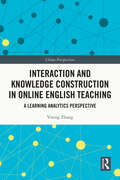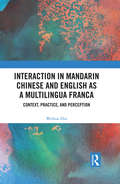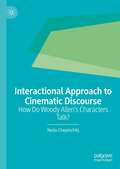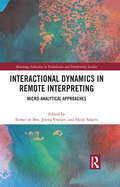- Table View
- List View
Interacting and Organizing: Analyses of a Management Meeting (Routledge Communication Series)
by François CoorenThis work provides an exceptional case study, shedding light onto the functioning of an actual corporate board of directors. It presents analysis of a series of corporate management meetings shown in the 1974 documentary film, Corporation: After Mr. Sam. The film chronicles the discussion and communication processes as a company considers how to replace its president, and it serves as a unique opportunity for analysis of real-world organizational discourse. With an impressive list of prominent contributors, Interacting and Organizing: Analyses of a Management Meeting employs the dual perspectives of organizational communication and language and social interaction (LSI) to examine the film. It is arranged around specific topics, analyzed separately by organizational communication and LSI scholars. Editor François Cooren provides an introduction for each topic, and a comparison and synthesis conclude each part. Readers will appreciate the information presented, as it is an arena typically off-limits to outside eyes. The transcript of the film is included as an appendix to the volume. This volume is appropriate for use in advanced courses and seminars in organizational communication, LSI, management, and organizational behavior. With its distinctive approach to studying the film's content, it will be invaluable to scholars, researchers, and graduate students in organizational communication, LSI, and management.
Interacting With Audiences: Social Influences on the Production of Scientific Writing (Rhetoric, Knowledge, and Society Series)
by Ann M. BlakesleeThis distinctive monograph examines the dynamic rhetorical processes by which scientists shape, negotiate, and position their work within an interdisciplinary community. Author Ann M. Blakeslee studies the everyday rhetorical practices of a group of condensed matter theoretical physicists, and presents here the first substantial qualitative study of the planning and implementation of discursive practices by a group of scientists. This volume also represents one of the first studies to use situated cognition and learning theory to study how knowledge of a domain's discursive practices is acquired by newcomers. Unlike previous studies of scientists' rhetorical practices, which have focused primarily on the finished or published texts, Blakeslee's involvement with the physicists as they engaged in the composing processes--from jotting down planning notes through publishing a scientific paper--suggests an alternative view of audience based on cooperative interaction between authors and their interlocutors. From this innovative perspective, functional knowledge of audiences comes only by entering into some community of practice, in which readers also become self-defining interlocutors and even participants in joint projects. Blakeslee's research follows the physicists' work into communal, interactive dynamics, looking at their overt attempts to get feedback from members of their audiences, what that feedback was, and how they responded to it. This work addresses and extends a model for audience analysis that consists of two primary operations: getting to know and understand one's interlocutors, and determining how to reach and influence them. In doing so, it offers important insights into the dissemination of scientific information, and thus will be of great interest to scholars and students in the areas of rhetoric of science and technology, composition, rhetorical theory, and scientific writing.
Interacting With Audiences: Social Influences on the Production of Scientific Writing (Rhetoric, Knowledge, and Society Series)
by Ann M. BlakesleeThis distinctive monograph examines the dynamic rhetorical processes by which scientists shape, negotiate, and position their work within an interdisciplinary community. Author Ann M. Blakeslee studies the everyday rhetorical practices of a group of condensed matter theoretical physicists, and presents here the first substantial qualitative study of the planning and implementation of discursive practices by a group of scientists. This volume also represents one of the first studies to use situated cognition and learning theory to study how knowledge of a domain's discursive practices is acquired by newcomers. Unlike previous studies of scientists' rhetorical practices, which have focused primarily on the finished or published texts, Blakeslee's involvement with the physicists as they engaged in the composing processes--from jotting down planning notes through publishing a scientific paper--suggests an alternative view of audience based on cooperative interaction between authors and their interlocutors. From this innovative perspective, functional knowledge of audiences comes only by entering into some community of practice, in which readers also become self-defining interlocutors and even participants in joint projects. Blakeslee's research follows the physicists' work into communal, interactive dynamics, looking at their overt attempts to get feedback from members of their audiences, what that feedback was, and how they responded to it. This work addresses and extends a model for audience analysis that consists of two primary operations: getting to know and understand one's interlocutors, and determining how to reach and influence them. In doing so, it offers important insights into the dissemination of scientific information, and thus will be of great interest to scholars and students in the areas of rhetoric of science and technology, composition, rhetorical theory, and scientific writing.
Interacting with Print: Elements of Reading in the Era of Print Saturation
by The Multigraph CollectiveA thorough rethinking of a field deserves to take a shape that is in itself new. Interacting with Print delivers on this premise, reworking the history of print through a unique effort in authorial collaboration. The book itself is not a typical monograph—rather, it is a “multigraph,” the collective work of twenty-two scholars who together have assembled an alphabetically arranged tour of key concepts for the study of print culture, from Anthologies and Binding to Publicity and Taste. Each entry builds on its term in order to resituate print and book history within a broader media ecology throughout the eighteenth and nineteenth centuries. The central theme is interactivity, in three senses: people interacting with print; print interacting with the non-print media that it has long been thought, erroneously, to have displaced; and people interacting with each other through print. The resulting book will introduce new energy to the field of print studies and lead to considerable new avenues of investigation.
Interacting with Print: Elements of Reading in the Era of Print Saturation
by The Multigraph CollectiveA thorough rethinking of a field deserves to take a shape that is in itself new. Interacting with Print delivers on this premise, reworking the history of print through a unique effort in authorial collaboration. The book itself is not a typical monograph—rather, it is a “multigraph,” the collective work of twenty-two scholars who together have assembled an alphabetically arranged tour of key concepts for the study of print culture, from Anthologies and Binding to Publicity and Taste. Each entry builds on its term in order to resituate print and book history within a broader media ecology throughout the eighteenth and nineteenth centuries. The central theme is interactivity, in three senses: people interacting with print; print interacting with the non-print media that it has long been thought, erroneously, to have displaced; and people interacting with each other through print. The resulting book will introduce new energy to the field of print studies and lead to considerable new avenues of investigation.
Interacting with Print: Elements of Reading in the Era of Print Saturation
by The Multigraph CollectiveA thorough rethinking of a field deserves to take a shape that is in itself new. Interacting with Print delivers on this premise, reworking the history of print through a unique effort in authorial collaboration. The book itself is not a typical monograph—rather, it is a “multigraph,” the collective work of twenty-two scholars who together have assembled an alphabetically arranged tour of key concepts for the study of print culture, from Anthologies and Binding to Publicity and Taste. Each entry builds on its term in order to resituate print and book history within a broader media ecology throughout the eighteenth and nineteenth centuries. The central theme is interactivity, in three senses: people interacting with print; print interacting with the non-print media that it has long been thought, erroneously, to have displaced; and people interacting with each other through print. The resulting book will introduce new energy to the field of print studies and lead to considerable new avenues of investigation.
Interacting with Print: Elements of Reading in the Era of Print Saturation
by The Multigraph CollectiveA thorough rethinking of a field deserves to take a shape that is in itself new. Interacting with Print delivers on this premise, reworking the history of print through a unique effort in authorial collaboration. The book itself is not a typical monograph—rather, it is a “multigraph,” the collective work of twenty-two scholars who together have assembled an alphabetically arranged tour of key concepts for the study of print culture, from Anthologies and Binding to Publicity and Taste. Each entry builds on its term in order to resituate print and book history within a broader media ecology throughout the eighteenth and nineteenth centuries. The central theme is interactivity, in three senses: people interacting with print; print interacting with the non-print media that it has long been thought, erroneously, to have displaced; and people interacting with each other through print. The resulting book will introduce new energy to the field of print studies and lead to considerable new avenues of investigation.
Interaction and Knowledge Construction in Online English Teaching: A Learning Analytics Perspective (ISSN)
by Yining ZhangWithin a Chinese English as a Foreign Language (EFL) learning context, this book investigates how teachers and learners interacted and articulated their understanding of English for Research Publication Purposes (ERPP)-related knowledge in a synchronous EFL classroom.The outbreak of the COVID-19 pandemic changed the way people receive education, causing an almost overnight switch from on-campus instruction to distance learning. Under the use of three different learning analytics approaches, this book has moved beyond the usual descriptive understanding of the online learning process to an in-depth exploratory and inferential analysis of the entities, structures, relations, and processes of learning. The findings enrich current understandings of the complexity of ERPP teaching and learning in synchronous learning contexts. These findings also drive us to rethink and reshape the way ERPP instruction is delivered post-pandemic.An essential read for students and scholars of education and academic English. This book will also be a vital source for researchers in the field of learning analytics, data analysis, and data interpretation in language teaching and learning.
Interaction and Knowledge Construction in Online English Teaching: A Learning Analytics Perspective (ISSN)
by Yining ZhangWithin a Chinese English as a Foreign Language (EFL) learning context, this book investigates how teachers and learners interacted and articulated their understanding of English for Research Publication Purposes (ERPP)-related knowledge in a synchronous EFL classroom.The outbreak of the COVID-19 pandemic changed the way people receive education, causing an almost overnight switch from on-campus instruction to distance learning. Under the use of three different learning analytics approaches, this book has moved beyond the usual descriptive understanding of the online learning process to an in-depth exploratory and inferential analysis of the entities, structures, relations, and processes of learning. The findings enrich current understandings of the complexity of ERPP teaching and learning in synchronous learning contexts. These findings also drive us to rethink and reshape the way ERPP instruction is delivered post-pandemic.An essential read for students and scholars of education and academic English. This book will also be a vital source for researchers in the field of learning analytics, data analysis, and data interpretation in language teaching and learning.
Interaction Between Attention and Language Systems in Humans: A Cognitive Science Perspective
by Ramesh Kumar MishraThis original volume examines the interface between attentional and linguistic processes in humans from the perspectives of psycholinguistics and cognitive science. It systematically explores how autonomy and automaticity are reflected during language processing in a variety of situations. A true, mechanistic explanation of how humans process language would require a complete understanding of the interface language has with important cognitive systems like attention, memory, as well as with vision. Interdisciplinary work in this area has so far not been able to generate a substantial theoretical position on this issue. This volume therefore looks at different language processing domains, such as speaking, listening, reading, as well as discourse and text processing, to evaluate the role attention plays in such performances; and also at how often linguistic inputs affect attentional processing. In this sense, it proposes that the attention--language interface is bidirectional. It also considers applied issues like language disorders, bilingualism and illiteracy, where the attention--language interface seems especially relevant as a theoretical apparatus for research investigations. Therefore, this volume brings closer theoretical explanations from the language sciences and cognitive sciences. It argues that language processing is multi-modal in its very essence and many conceptual structures in language evolve out of a complex interplay among participating cognitive systems such as attention and memory, supported by vision and audition.
Interaction in Mandarin Chinese and English as a Multilingua Franca: Context, Practice, and Perception
by Weihua ZhuInteraction in Mandarin Chinese and English as a Multilingua Franca: Context, Practice, and Perception proposes a model of context, practice, and perception and raises awareness of the importance of understanding language use and perception in context in order to avoid intercultural communication misunderstandings. This book provides an overview of previous research on the pragmatics of Chinese and English as a multilingua franca in multilingual contexts. It argues that context is socioculturally shaped, interactionally constructed, and personally related. Context can influence and be established by the practice and perception of communicative acts. This book also combines the proposed model with the discursive-interactional approach to uncover the interplay of context, practice, and perception of extended concurrent speech for strong disagreement by native Chinese speakers in spontaneous conversations in Mandarin and English as a multilingua franca.
Interaction in Mandarin Chinese and English as a Multilingua Franca: Context, Practice, and Perception
by Weihua ZhuInteraction in Mandarin Chinese and English as a Multilingua Franca: Context, Practice, and Perception proposes a model of context, practice, and perception and raises awareness of the importance of understanding language use and perception in context in order to avoid intercultural communication misunderstandings. This book provides an overview of previous research on the pragmatics of Chinese and English as a multilingua franca in multilingual contexts. It argues that context is socioculturally shaped, interactionally constructed, and personally related. Context can influence and be established by the practice and perception of communicative acts. This book also combines the proposed model with the discursive-interactional approach to uncover the interplay of context, practice, and perception of extended concurrent speech for strong disagreement by native Chinese speakers in spontaneous conversations in Mandarin and English as a multilingua franca.
Interaction in the Language Curriculum: Awareness, Autonomy and Authenticity (Applied Linguistics and Language Study)
by Leo Van LierInteraction in the Language Curriculum offers an innovative theory of language education integrating curriculum practice, research and teaching. It emphasises the interdependence of knowledge and values and stresses the central importance of learning as a social process.Leo van Lier argues that moral as well as intellectual and practical principles must underlie curriculum development and everyday teaching, captured in his triple focus on Awareness, Autonomy, and Authenticity. In addition to its rich grounding in language education practice, the book draws support for his position from diverse sources in sociology, philosophy and cognitive science, from the work of Bourdieu, Giddens, Wittgenstein, Peirce, Vygotsky, Bakhtin, and Dewey. In the current broadening context of language education this study makes an important contribution to research. It presents a coherent philosophical theory as well as considering practical issues in implementation of a new language curriculum. As such, it will be of great benefit to teachers, applied linguists and educationalists generally.
Interaction in the Language Curriculum: Awareness, Autonomy and Authenticity (Applied Linguistics and Language Study)
by Leo Van LierInteraction in the Language Curriculum offers an innovative theory of language education integrating curriculum practice, research and teaching. It emphasises the interdependence of knowledge and values and stresses the central importance of learning as a social process.Leo van Lier argues that moral as well as intellectual and practical principles must underlie curriculum development and everyday teaching, captured in his triple focus on Awareness, Autonomy, and Authenticity. In addition to its rich grounding in language education practice, the book draws support for his position from diverse sources in sociology, philosophy and cognitive science, from the work of Bourdieu, Giddens, Wittgenstein, Peirce, Vygotsky, Bakhtin, and Dewey. In the current broadening context of language education this study makes an important contribution to research. It presents a coherent philosophical theory as well as considering practical issues in implementation of a new language curriculum. As such, it will be of great benefit to teachers, applied linguists and educationalists generally.
The Interaction of Focus, Givenness, and Prosody: A Study of Italian Clause Structure (Oxford Studies in Theoretical Linguistics #57)
by Vieri Samek-LodoviciThis is an open access title available under the terms of a CC BY-NC-ND 4.0 International licence. It is free to read at Oxford Scholarship Online and offered as a free PDF download from OUP and selected open access locations. This book provides an in-depth investigation of contrastive focalization in Italian, showing that its syntactic expression systematically interacts with the syntactic expression of discourse-given phrases. Vieri Samek-Lodovici disentangles the properties genuinely associated with contrastive focalization from those determined by highly productive operations affecting discourse given phrases in Italian, namely right dislocation and marginalization. Based on a vast aggregate of evidence, he shows that in the default case contrastive focalization occurs in situ and that left-peripheral focalization patterns arise from the interaction with right dislocation and generalize well beyond the familiar cases examined in Rizzi (1997) and most literature since. In the final chapter, the author examines how the key properties unveiled in the previous chapters, such as focalization in situ, follow from the prosodic constraints governing stress placement, thus reinterpreting and extending Zubizarreta's (1998) insight about the role of prosody in shaping syntax. Overall, the book offers an evidence-backed radical departure from current views of focalization that posit a high, fixed, focus projection at the left periphery of the clause. It also provides the most comprehensive study of Italian marginalization and right dislocation available to date.
Interaction of Morphology and Syntax in American Sign Language (Routledge Library Editions: Syntax)
by Carol A. PaddenThis study, first published in 1988, examines cases of interaction of morphology and syntax in American Sign Language and proposes that clause structure and syntactic phenomena are not defined in terms of verb agreement or sign order, but in terms of grammatical relations. Using the framework of relational grammar developed by Perlmutter and Postal in which grammatical relations such as "subject", "direct object", etc. are taken as primitives of linguistic theory, facts about syntactic phenomena, including verb agreement and sign order are accounted for in a general way. This title will be of interest to students of language and linguistics.
Interaction of Morphology and Syntax in American Sign Language (Routledge Library Editions: Syntax)
by Carol A. PaddenThis study, first published in 1988, examines cases of interaction of morphology and syntax in American Sign Language and proposes that clause structure and syntactic phenomena are not defined in terms of verb agreement or sign order, but in terms of grammatical relations. Using the framework of relational grammar developed by Perlmutter and Postal in which grammatical relations such as "subject", "direct object", etc. are taken as primitives of linguistic theory, facts about syntactic phenomena, including verb agreement and sign order are accounted for in a general way. This title will be of interest to students of language and linguistics.
Interaction Process and Chinese EFL Learners’ Proficiency Development: A Cognitive and Interactionist Approach
by Shanshan GuThis book provides readers a better understanding of the interaction-learning relationship in the English as a Foreign Language (EFL) context. It introduces theories on input, output, and learners’ internal mechanisms, and presents the pedagogical implications of how to adapt focus-on-form instruction in Chinese EFL classrooms. As such, it will be of particular interest to those readers who want to explore the relationship between interaction and language acquisition.
Interactional Approach to Cinematic Discourse: How Do Woody Allen’s Characters Talk?
by Neda ChepinchikjThis book analyses and describes a segment of Woody Allen’s cinematic discourse, focusing specifically on the performed (or diegetic) interactions between actors in various roles in some of his films. It is a case study of Woody Allen's cinematic discourse, encompassing the on-screen, performed interaction in the films at the level of the story-world. The analysis focuses on speech (film dialogues), in both its verbal and prosodic forms, as well as non-verbal types of interaction including gaze and gesture, taking a social interactional approach and using multimodal conversation analysis as a theoretical framework and analytical tool. The 'texts' under study are segments from five films by Woody Allen, and the analysed interactions take place between male and female interactants, which allows further examination of on-screen interactions via a gender lens. The book aims to bridge the gap between the disciplines of applied linguistics and cinema studies and offer linguistic insights into performed interactions from a multimodal point of view. It will be equally relevant to linguists who are interested in how verbal and non-verbal language is used in cinematic discourse, as well as to film workers, especially actors, directors and screenwriters.
Interactional Competences in Institutional Settings: From School to the Workplace
by Simona Pekarek Doehler Adrian Bangerter Geneviève De Weck Laurent Filliettaz Esther González-Martínez Cécile PetitjeanThis interdisciplinary volume brings together leading scholars from several disciplines to uncover the key to young people’s socialization within institutional settings, from school to the workplace. Among the questions they consider are: what aspects of interactional competence are relevant for participation in practical activities within those settings? What are the interactional procedures through which diverse facets of interactional competence are recognized, legitimized and assessed in the course of practical activities? How do these procedures shape and reflect social institutions and people's understanding of them? The collection discusses interactional competences across a variety of institutional settings, and reflects on the institutional order by scrutinizing how such competences are interactionally treated within everyday institutional practices. The volume enriches an interdisciplinary understanding of fundamental concepts in the social sciences and will therefore be of interest to those working within linguistics, sociology, education, psychology of work, and speech therapy.
Interactional Competences in Institutional Settings: From School to the Workplace
by Simona Pekarek Doehler Adrian Bangerter Geneviève De Weck Laurent Filliettaz Esther González-Martínez Cécile PetitjeanThis interdisciplinary volume brings together leading scholars from several disciplines to uncover the key to young people’s socialization within institutional settings, from school to the workplace. Among the questions they consider are: what aspects of interactional competence are relevant for participation in practical activities within those settings? What are the interactional procedures through which diverse facets of interactional competence are recognized, legitimized and assessed in the course of practical activities? How do these procedures shape and reflect social institutions and people's understanding of them? The collection discusses interactional competences across a variety of institutional settings, and reflects on the institutional order by scrutinizing how such competences are interactionally treated within everyday institutional practices. The volume enriches an interdisciplinary understanding of fundamental concepts in the social sciences and will therefore be of interest to those working within linguistics, sociology, education, psychology of work, and speech therapy.
Interactional Dynamics in Remote Interpreting: Micro-analytical Approaches (ISSN)
by Esther De Boe Jelena Vranjes Heidi SalaetsThis collection introduces an innovative micro-analytical approach to interaction management in remote interpreting, offering new insights into our understanding of the conversational dynamics of remote dialogue interpreting.The book calls attention to the need for greater reflection on the impact of the increased use of remote interpreting via telephone and video link, particularly in light of the COVID-19 pandemic, on the already complex interactional dynamics of communication in dialogue interpreting settings. Featuring perspectives from both established and emerging scholars, the volume explores both the signals and mechanisms of interaction management and the effects of context in such settings. Chapters draw on empirical studies based on experimental and authentic data from video recordings and eye-tracking data to examine the impact on smoothness and synchronization of the interaction in remote interpreting, in light of the absence of multimodal resources such as gaze and gesture. In collecting this research in a single volume, the book paves the way for further research on the changing relationships between interaction management, technology, and multimodality in dialogue interpreting contexts in today’s increasingly technology-mediated world.This volume will be of interest to students and scholars in interpreting studies, language and communication, and pragmatics.
Interactional Dynamics in Remote Interpreting: Micro-analytical Approaches (ISSN)
by Esther De Boe Jelena Vranjes Heidi SalaetsThis collection introduces an innovative micro-analytical approach to interaction management in remote interpreting, offering new insights into our understanding of the conversational dynamics of remote dialogue interpreting.The book calls attention to the need for greater reflection on the impact of the increased use of remote interpreting via telephone and video link, particularly in light of the COVID-19 pandemic, on the already complex interactional dynamics of communication in dialogue interpreting settings. Featuring perspectives from both established and emerging scholars, the volume explores both the signals and mechanisms of interaction management and the effects of context in such settings. Chapters draw on empirical studies based on experimental and authentic data from video recordings and eye-tracking data to examine the impact on smoothness and synchronization of the interaction in remote interpreting, in light of the absence of multimodal resources such as gaze and gesture. In collecting this research in a single volume, the book paves the way for further research on the changing relationships between interaction management, technology, and multimodality in dialogue interpreting contexts in today’s increasingly technology-mediated world.This volume will be of interest to students and scholars in interpreting studies, language and communication, and pragmatics.
The Interactional Feedback Dimension in Instructed Second Language Learning: Linking Theory, Research, and Practice (Advances in Instructed Second Language Acquisition Research)
by Hossein NassajiThis book examines current advances in the role of interactional feedback in second language (L2) teaching and learning. Drawing on recent theory and research in both classroom and laboratory contexts, the book explores a wide range of issues regarding interactional feedback and their relevance for both theory and practice, including how interactional feedback is used, processed, and contributes to L2 acquisition. This book will provide a useful resource for applied linguistics students and academics as well as language teachers and teacher educators who would like to gain insight into the role of interactional feedback and how it can be used as a means of integrating form and meaning in classroom contexts.
The Interactional Feedback Dimension in Instructed Second Language Learning: Linking Theory, Research, and Practice (Advances in Instructed Second Language Acquisition Research)
by Hossein NassajiThis book examines current advances in the role of interactional feedback in second language (L2) teaching and learning. Drawing on recent theory and research in both classroom and laboratory contexts, the book explores a wide range of issues regarding interactional feedback and their relevance for both theory and practice, including how interactional feedback is used, processed, and contributes to L2 acquisition. This book will provide a useful resource for applied linguistics students and academics as well as language teachers and teacher educators who would like to gain insight into the role of interactional feedback and how it can be used as a means of integrating form and meaning in classroom contexts.














